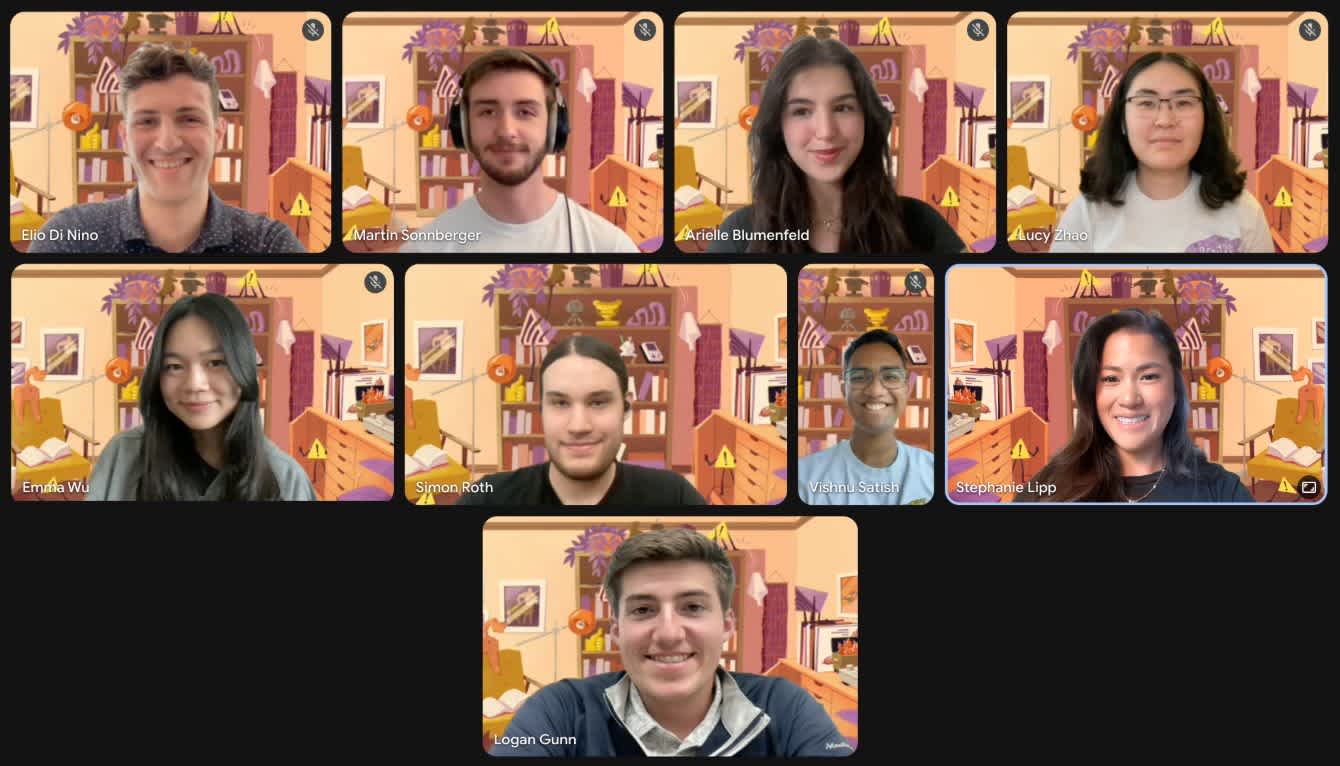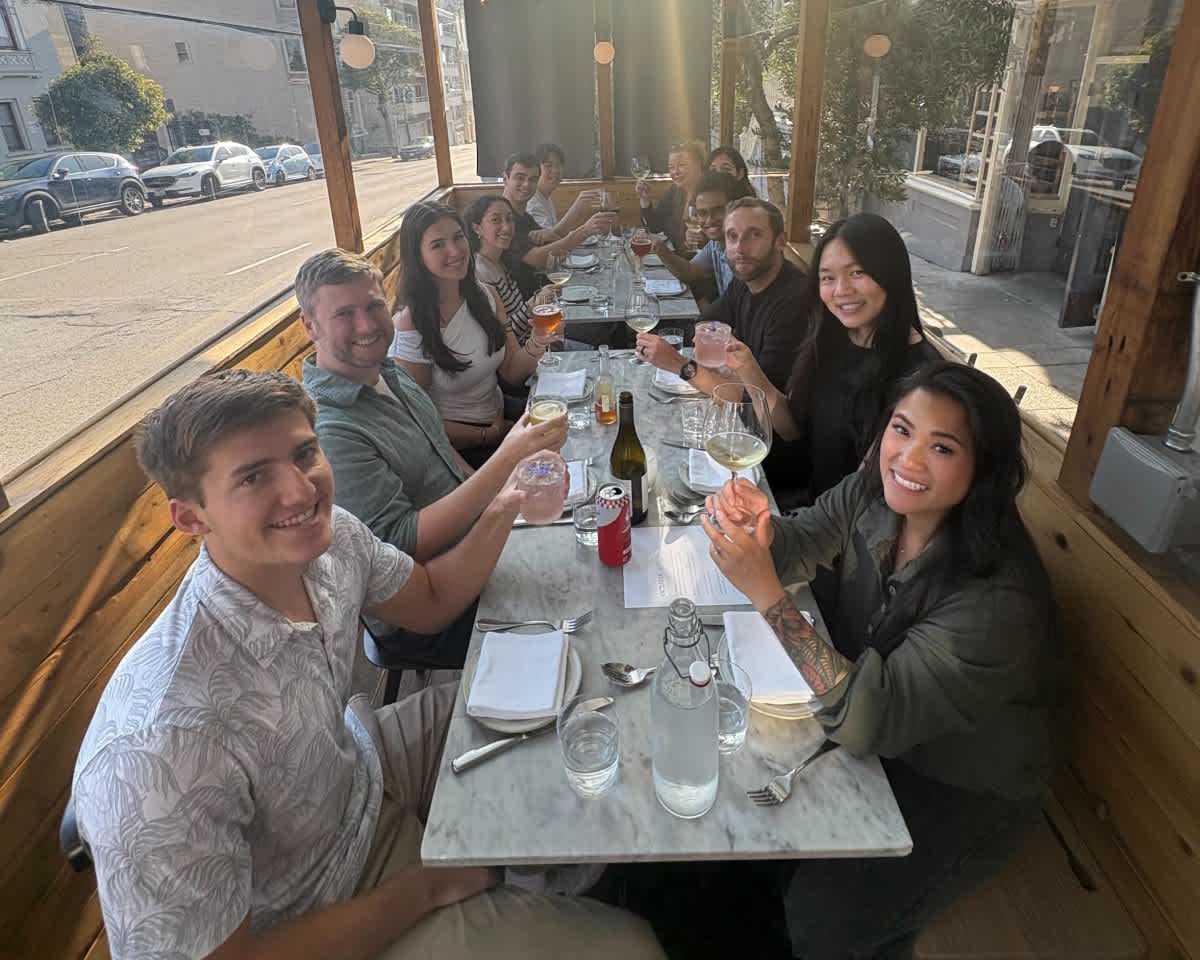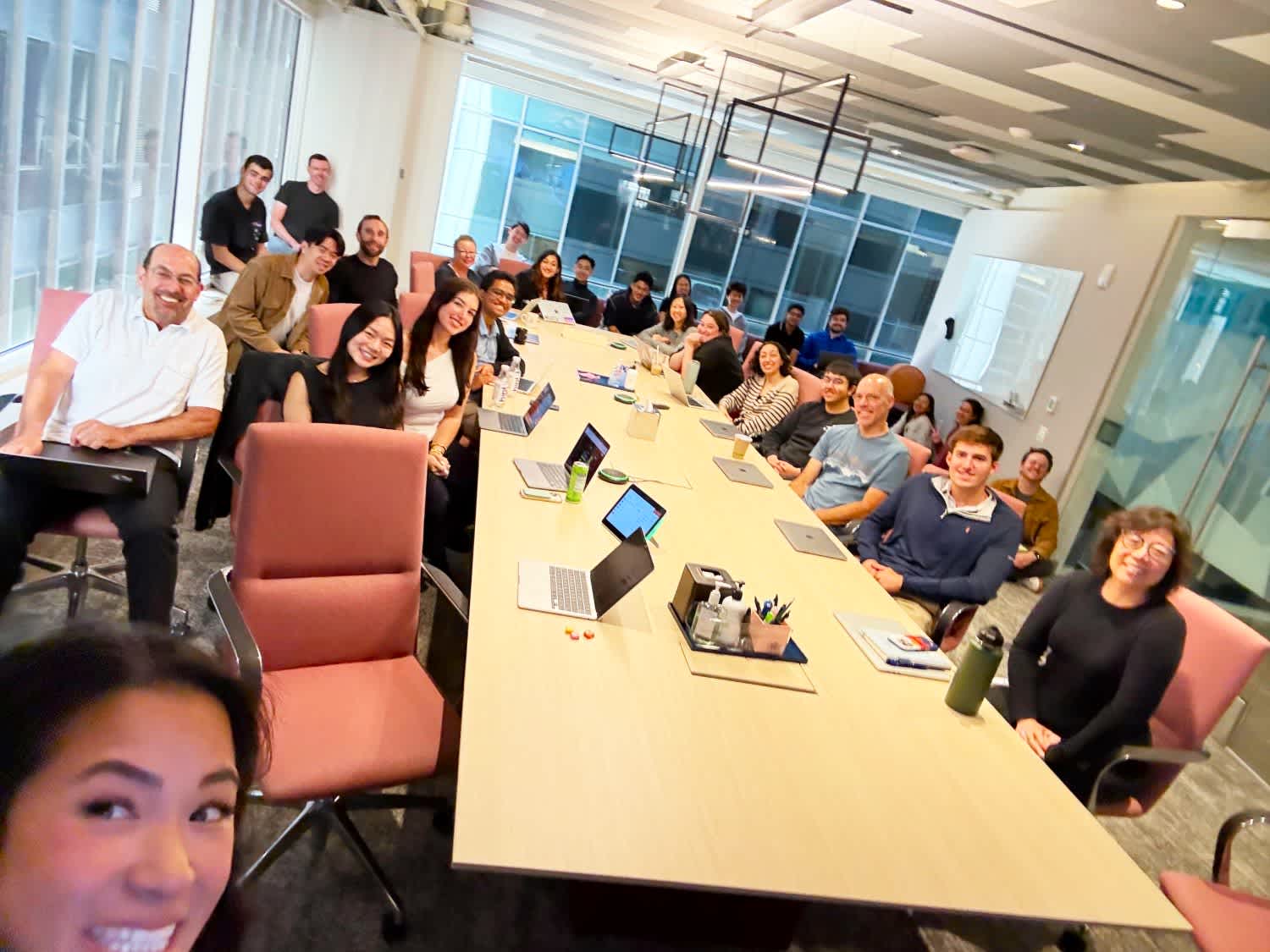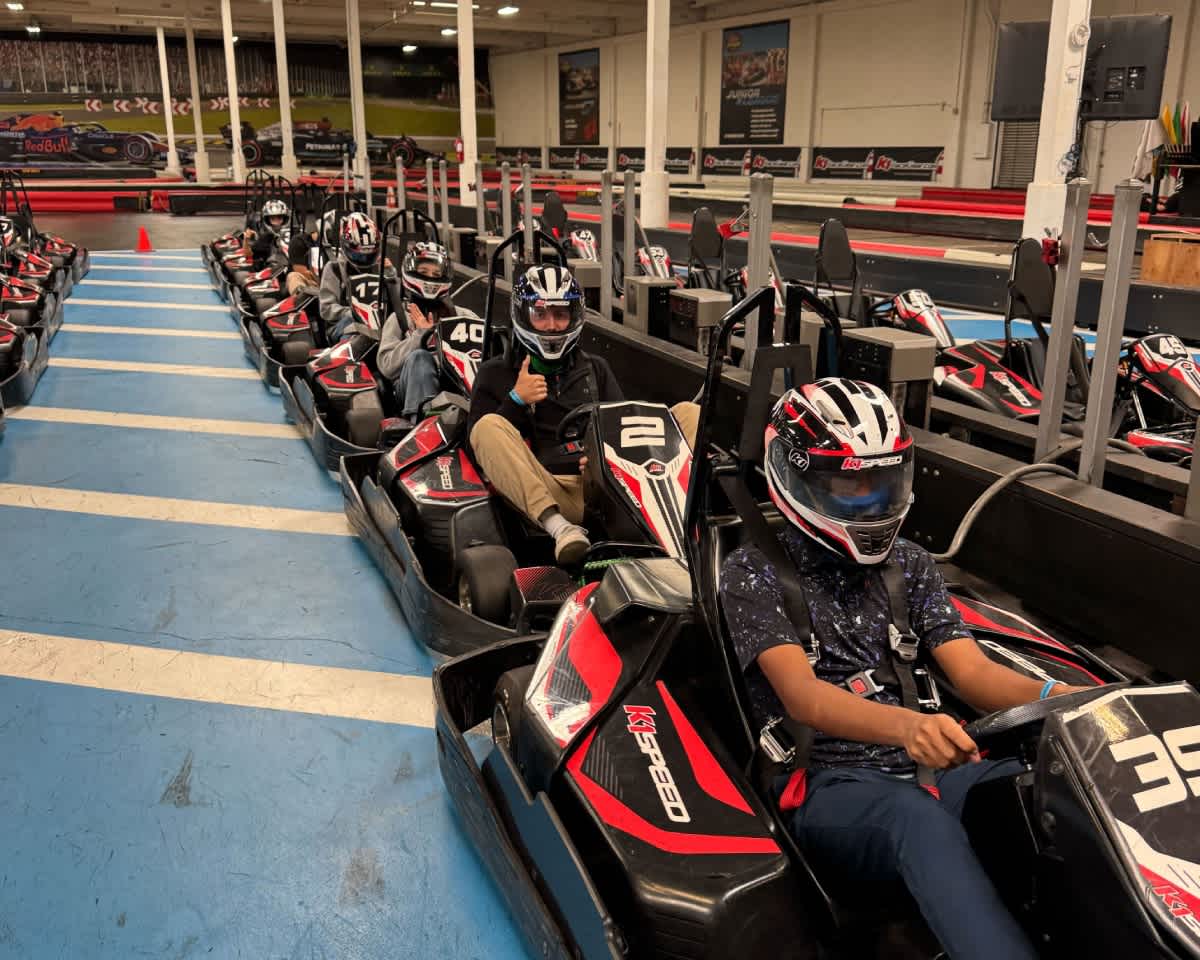Meet Sentry’s 2025 summer interns
Meet Sentry’s 2025 summer interns
At Sentry, interns aren’t just along for the ride, they’re part of the team. This summer, our crew of software engineers, biz ops problem-solvers, and even an accounting pro rolled up their sleeves and tackled real projects with real impact. They debugged, crunched numbers, streamlined processes, and brought fresh ideas that kept us on our toes. Beyond the skills they gained in engineering, operations, and finance, they showed us what the next generation of talent is all about. Here’s a look at their stories ✨.
Why Sentry?
Vishnu
I found about Sentry since I used it at a previous internship and honestly, during stressful production issues, it turned out to be a lifesaver. The amount of context it provided made debugging way less painful. So when I saw the internship posting, I knew I had to apply. Going through the interviews and talking to my team reinforced my excitement to join Sentry!
Arielle
The kind and intelligent people at Sentry truly make it an incredible place to intern. Of course there are other reasons to intern here, like high-impact projects and fun perks, but the Sentaur community is unlike anything I have experienced before. By my third week, I was already looking forward to my in-person days more than my remote ones.
People here are genuinely human, genuinely curious, and genuinely helpful. One moment you might be talking about book recommendations or the best local gyms, and the next you’re discussing the latest tech news. When it comes to work, no one hesitates to walk me through how they use a KPI or answer questions in depth. What makes the Sentry community memorable is how approachable people are, how much they care about the developer world, and how generous they are with their time.
Emma
What drew me in at first was Sentry’s incredible marketing. Seeing the effort and thought that went into the design of Sentry’s website, graphics, and the sarcastic little jokes sprinkled throughout their socials piqued my interest and made me excited about working there.
The reason why I picked Sentry is because of the incredible experience I had throughout the recruitment process and its emphasis on culture. Throughout my conversations with multiple people on the team, I could tell that Sentry’s culture was something truly special that I definitely wanted to be a part of.
Logan
I’d heard about Sentry from both friends and family and talking to people on the accounting team boosted my excitement about the role!
Elio
I first heard about Sentry from a friend a few years back who was using it for a personal project. Not long after, I was also using the product on the generous student plan and really enjoyed it. After having applied to a Sentry internship once before, I tried again last year and was fortunate enough to make it to (and later pass) the interview process. Talking with the engineers, hiring manager, and my recruiter throughout the process only reinforced my desire to work at the company. Everyone spoke super passionately, had clear technical expertise, and seemed to genuinely enjoy the company.
Having now been at Sentry for a little over 3 months, I can confidently say that it was not just a facade; Sentry is n great place to work with a lot of amazing people!
Lucy
This is two-layered for me. My reason on why Sentry has changed from before I started versus now (as of writing this, I am at my last week).
I was exposed to Sentry from previous internships, and got a surface level introduction to the platform. When I saw they were hiring interns, I thought it would have been an awesome experience to learn more. I actually applied for summer 2024, but got rejected the first time around. After completing two other internships in between, I reapplied for summer 2025 with a lot more experience under my belt. Since I'm writing this, I ended up making it through the process!
Now that my internship is coming to an end, I can say the people who are a part of Sentry are a huge reason to work here. As part of the Toronto office, the people here are top notch and are very nice. Too nice, in fact, because it did get on my nerves a bit. It’s definitely from pressure to try my best and not disappoint, but everyone I worked with was genuinely supportive!
Simon
Prior to starting my internship, I have not had the opportunity to use Sentry. However, I only heard positive things about both the product and the company online and from friends. Exploring Sentry with all its features in sandbox mode for a while and reading more about the company and culture left me very impressed and got me really excited about doing an internship here!
Martin
While I haven’t used Sentry before I started, I only heard great things about it all over the internet. Sentry’s marketing and especially their fun careers page convinced me that this must be a great place to work. Turns out it is! Also, it’s definitely one of the coolest companies in Vienna!
What did you work on?
Vishnu
I was on the Session Replay team, and I worked mainly on the User Feedback product which our team owns. I focused on developing a couple of AI-powered features that made it easier to track, triage, and surface the most common themes in user feedback.
After onboarding to the codebase by fixing some bugs and making small improvements, I started with summarization, which is now in EA! The goal was to generate a one-sentence summary of the list of user feedback using an LLM. To systematically analyze improvements in the prompt and context, I developed some AI-powered evaluation tooling, which turned out to be useful for my second project too.
My main project was categorization, a feature designed to group feedback into the top 3-4 recurring themes and allow users to search and filter by them. After experimenting with various ML methods (clustering, embeddings, etc.) I ended up settling on a two-step approach powered by LLMs and some heuristics. This project came with a few challenges, especially related to generalizing the pipeline to different volumes of feedback and ensuring the categories were specific enough to be actionable.
Implementing these features were a full-stack effort, from working with the core AI logic, the feedback ingestion pipeline, and different databases (ClickHouse, PostgreSQL), to developing Django APIs and the frontends that users interacted with.
Arielle
Unlike software engineering interns that typically spend their summer working on one major project, I spent my summer working on 6! The projects I took on were things that the strategy and ops team genuinely needed to complete. No tasks were created specially for me because I am an intern; the work would have landed on someone else’s plate had I not been there.
Over the summer, I worked on everything from analyzing customer categories to redefining industry benchmarking across all of Sentry’s products. I even joined my first hackathon, where my team and I built a food recommendation app that integrated Slack and maps APIs.
My favorite project was improving our internal metrics we use to understand how much value customers get from Sentry. I built dashboards in Looker to explore data correlations, interviewed seven colleagues across Sales, Product Marketing, Product Management, and leadership to gather use cases, and turned those into a deck for the company. I also presented at Sentry’s monthly demo session and created onboarding materials so every new hire would understand it. It was both surreal and exciting to see my work being used so quickly and at scale.
Emma
As a Business Intelligence Intern on the Data & Analytics Team, I worked on several projects during my internship.
After spending my first two weeks getting familiar with Sentry’s BizOps team and learning the process of building Looker dashboards, I kicked off my first project with the Marketing team. The goal was to create a dashboard that could highlight how well Sentry’s Docs were performing and surface areas for improvement.
One challenge I faced was that our available conversion data was limited, which required me to take a more creative approach in finding useful signals. I turned to Kapa, the chatbot on Sentry’s Docs site, to source data on how our docs are being used and uncover patterns.
With this data, I built a dashboard that shows conversion rates and question volumes across different products, SDKs, and platforms. This gave the Marketing team a clear view of where users had high question volumes and low conversion rates, helping them prioritize improvements to documentation.
My next project focused on making improvements to how we track financial forecasts. Previously, our dashboards were based on static end-of-quarter forecast values, which made it hard to understand if we were on pace throughout the quarter. The goal of this project was to update reporting, providing a daily view of our product forecasts. This gave the Strategy team a clear-cut way to understand whether we were on track throughout the quarter.
My third project involved creating a dashboard to clearly deliver new customer phase logic developed by the Strategy team, providing clearer insights into how different types of customers engage with Sentry’s products. My final project dealt with SDK attribution, in which I developed a restructured system and a dashboard to deliver insights about revenue from an SDK perspective.
I was so grateful to have been assigned several projects that made real impact and improvements to Sentry’s internal operations and business strategy. Working with so many different people on several different teams also gave me a wider perspective of what the Business Intelligence role entailed, and I am so glad that I was able to learn so many new skills throughout my 12 weeks at Sentry.
Logan
My daily and monthly administrative tasks centered on ensuring the accuracy and integrity of Sentry's financial records. This included performing daily bank reconciliations on NetSuite to ensure the internal cash records align perfectly with its bank statements. I also helped with the monthly close process through monthly account reconciliations for both the operating cash and payroll accounts which provided a comprehensive financial snapshot for management and auditors.
In addition, my main project was creating a centralized spreadsheet database to track all vendor contracts. This project was meant to improve operational efficiency by syncing with the company's billing process in NetSuite. By comparing internal records with NetSuite's, the database helps catch and rectify discrepancies, thereby reducing the risk of missed bills or payment errors. Scraping Netsuite data came with challenges but working through those was my favorite part of the role!
Elio
I was on the Codecov team, a company Sentry bought a few years ago, and that is actively in the process of integrating product offerings into Sentry. To say it was a busy time to join would be an understatement. That being said, it brought numerous opportunities to make a big impact and accelerated my skills as a software engineer.
To get the ball rolling, my first task was enabling dynamic use of Sentry’s GitHub app instead of Codecov’s to interact with GitHub. This is because Codecov’s backend is being used for some of the new products within Sentry and was not initially designed to use other apps to talk to GitHub. Many lines of code read and modified later, I successfully implemented the support for Sentry’s GitHub app we needed. I later found out that my task was pretty critical to the ongoing work of the team, but that information was kindly withheld until after I finished (to keep the pressure off 😆). With that task out of the way, I had much more familiarity with the codebase and was ready to take on more.
A large portion of my internship was spent adding per-upload observability into Codecov’s main processing pipeline. For those who don’t know, Codecov’s core product is taking customer-uploaded coverage reports from test runs and then displaying them in multiple places including a web app, PR comments, Slack messages, etc. Although it seems simple on the surface, a lot goes on behind the scenes to process these reports. Like any system, there are also bugs and occasional failures due to high concurrent usage. Without any centralized way to follow an upload through our pipeline it is very difficult for our support and Codecov engineers to debug specific customer uploads. To solve this issue, I spent a lot of time implementing what came to be known as upload breadcrumbs. These breadcrumbs are sprinkled throughout every part of our upload pipeline and give us centralized, searchable, and near-instantaneous information on current and past uploads. I’ll spare most of the details, but I gained a lot of skills using Django, Celery, and PostgreSQL to complete the project. The breadcrumbs are architected in a fully event-driven way, meaning that they operate largely adjacent to the existing pipeline to minimize disruptions and performance overhead. Additionally, breadcrumbs are saved in a partitioned table to enable automatic deletion based on a retention period and are fast to search for thanks to a number of database indexes. In combination with an administrative UI, my project has enabled support and Codecov engineers to be able to quickly debug and give relevant information to customers, saving countless hours.
Both during and following my main project, I also made a number of improvements and bug fixes to the codebase. This included a total of 500k fewer production warning logs every week, a reduction of 90% of test warnings, and countless Python typing fixes. Some of my time was also spent consolidating our bootup and migration scripts for our backend applications across all of our environments.
Overall, I got to interact with a ton of different things and was able to implement changes that will have a lasting impact on the team. I am proud of my work and super grateful to the team for their support and mentorship.
Lucy
I was part of the Dashboards and Insights team under Performance. I think I did quite a few miscellaneous tickets and bug fixes. Part of it was getting onboarded, and part of it was just having some downtime while working on my main project.
Speaking of which, my main project was a major overhaul to table widgets in Dashboards. Tables in Sentry are a whole mess with developers writing their own variation of arguably the same table in multiple places. Dashboards are no exception. Worse yet, there's no feature parity between these tables. For example, some of the tables support sorting, while some don’t. So I focused on rewriting a lot of the code to use a single, easy-to-use table. I added a whole bunch of default behaviour, as there was a lot of duplicated code to handle cell rendering, sorting and column resizing. After that, I was finally able to remove a lot of the old tables in Dashboards.
Another component I overhauled was table cell actions. This wasn’t originally a Dashboards table feature, but rather a one-off feature for a small subset of tables in Sentry. For context, there are tables that include this ellipsis dropdown menu. The trigger for the menu just wasn’t clear and it should have been a generic table feature in the first place. The overall change was to make it a bold hover on the cell text, and add more features like opening links, copying text and opening table rows in Explore to view more related samples.
Simon
During my time as a Software Engineering Intern at Sentry I was part of the Web Backend SDK Team, which is responsible for building and maintaining all of the Sentry Backend SDKs. My work was focused primarily on improving async support for the Sentry Python SDK.
Over the course of my internship, I had the opportunity to work on several different projects. My main project was designing and implementing an asynchronous transport for the Python SDK. Previously, the transport for Python was strictly synchronous and used a threaded background worker to process HTTP requests. This led to many thread context switches as well as synchronous HTTP requests, which meant that especially in asynchronous applications with a high volume of sampled errors, the SDK had a noticeable impact on performance. To improve SDK performance for async applications, I adapted the threaded background worker as an async task and added a new asynchronous HTTP transport layer. This eliminates the biggest transport related async performance bottlenecks in the SDK, and brings the SDK more in line with the modern async/await Python ecosystem.
After finishing the async transport, which I later also shipped, I investigated the rest of the SDK for potential further async improvements. As it turns out, all blocking I/O operations in the SDK lead back to the transport, meaning the async transport already solves the majority of async issues within the Python SDK! While looking over the rest of the SDK, I was additionally able to resolve some long-standing user issues related to async support.
The rest of my internship was spent on more open-ended research tasks. First, I investigated the behavior of asynchronous stack traces in Python. Afterwards, I spent my last weeks investigating potential ways of improving websocket instrumentation for Sentry SDKs. While working on these research tasks, I created detailed overviews of my findings and laid out starting points and plans for any future work on these topics.
Martin
I was a Software Engineering Intern on the JavaScript SDK team, where we build and maintain all 34 (yes, it’s a lot) JavaScript SDKs for all the libraries and frameworks out there. My project was focused on improving our AWS Serverless SDK, which hasn’t seen the love it deserves in the past.
My first milestone was to improve the experience for users running their Lambda function in ESM (ES Modules), as opposed to CJS (CommonJS). We previously offered our Lambda layer for CJS only, and our NPM package, which has always been available for both CJS and ESM, needed manual wrapping for Sentry’s instrumentations to work. I built and shipped a new Lambda layer that also supports ESM and added automatic instrumentation for ESM as well, making Sentry much easier to set up and use. Since new Lambda functions that you create via the AWS UI are always ESM by default nowadays, this is especially helpful for new users just starting out with Lambda functions and Sentry. This change also allowed us to drastically simplify our docs, since we don’t have to explain the intricate (and sometimes confusing) differences between ESM and CJS anymore.
Next, I added support for streaming handlers in AWS Lambda. This is a feature that AWS started offering in 2023, it allows users to send a handler’s response in chunks using a response stream. We previously didn’t support these special handlers, but with some changes to our SDK and the AWS Lambda instrumentation from OpenTelemetry, this is now supported with no further code changes needed from our users!
My last major milestone was to build a new AWS Lambda extension. An extension contains a separate process that runs alongside your function code. To reduce response times of Lambda functions, we run a simple HTTP proxy server in this new extension, that receives events from SDK running in the function handler and forwards them to Sentry. This significantly reduces response times, with first tests showing up to 25% faster request processing times.
Finally, I also improved our E2E test that we use to test our AWS SDK. Previously, we tried to replicate a Lambda runtime environment by mocking event and context objects manually. Now, we define our test handlers using the AWS CDK and start a real (but still local) Lambda environment using AWS SAM. This improves confidence when shipping new features and allows us to test things like the extension and streaming locally and in CI.
What was the internship like?
Vishnu
My internship at Sentry was really fun, and I learned a lot from many smart people here! I appreciated the autonomy I got to take the project in the direction I felt was right, while also being able to ask questions and receive feedback from everyone on my team. There were also a lot of fun events, like countless dinners and going go-karting with fellow interns. My team also had a weeklong offsite to Toronto, which I was grateful to be able to participate in! I think one of the main reasons I had a great time was because of my awesome team, everyone was so supportive and they were a lot of fun to be around!
From a technical standpoint, it was a great deep-dive into the practical challenges of applying AI and ML to solve real customer problems. From prompt/context engineering and LLM-based evaluations, to integrating it all into the codebase, I hope what I built makes user feedback more actionable for Sentry’s customers!
Arielle
I truly loved my internship experience. As a strategy and ops intern, no two days looked the same. I was jumping between projects, sitting in on product launch meetings, and even joining fun offsites (puppy yoga with BizOps is tough to beat).
What I appreciated most was the balance between being supported as a student and being trusted with real responsibility. People knew I was here to learn and would make mistakes, but they also gave me space to take on projects that mattered. By the end of the summer, I had learned a lot about strategy, operations, the developer world, and myself. It was a summer of growth, and one I will always be grateful for.
Emma
My experience at Sentry was incredible. I worked on a supportive team of other Business Intelligence Analysts and Data Engineers, and they were always willing to review my code and give me feedback on my approaches to solving problems. I also found it incredible that I was encouraged to advocate for myself and to explore any tasks that I personally wanted to learn about, even if they were not included in my original project scopes. My manager, mentor, and project collaborators gave me a lot of guidance and support, but at the same time, gave me a lot of autonomy. This gave me the creative freedom to solve problems on my own, which has helped me develop the ability to think creatively and understand my own work on a deeper level.
Overall, my experience at Sentry was transformative. I grew as a problem solver and communicator, and I am extremely grateful to have had the immense support from such an incredible team. And of course, I had a ton of fun getting to know so many passionate people who make the culture at Sentry so vibrant.
Elio
Working for Sentry has been an absolute dream. I got to work on so many interesting projects while also being surrounded by amazing people. My work consistently provided a good balance of challenge and enjoyment, complemented by various intern and office events, weekly happy hours, and lively lunches. At Sentry you are surrounded by people who are both super intelligent, but who also care. My mentor and manager exemplified this by regularly checking in with me while also pushing me to become a better engineer.
Thanks to my time at Sentry, I am walking away with so many new and refined skills as well as numerous invaluable connections.
Logan
The internship was super enjoyable! Beyond the fun offsites and dinners, I met so many cool, smart people in the finance and BizOps departments and beyond. Everyone was really supportive while providing me the autonomy in the role to problem solve. I was able to hone my Airbase and Netsuite skills along with realizing the powers of spreadsheets for organizing and presenting complex data!
Lucy
If my “why Sentry” wasn’t clear enough, the people at Sentry made this internship awesome! Sentry has a well-structured engineering internship program, pairing me with a mentor from my team. Everyone on my team was supportive and I never felt like “just an intern” or isolated. A huge advantage to interning at a company like Sentry is being able to take ownership of a project and actually having the speed to ship code without being limited by slow development processes.
The coolest part of the summer internship is taking part in Sentry’s hackweek, which is a week-long hackathon. It’s a unique experience to take time to learn new skills, while also being full of fun social events. Social events are not only limited to hackweek, there were plenty of events that happened throughout my internship. None of them were intern-only events, but I actually preferred that, because it meant I could meet more people in the office.
Simon
My internship has been a great experience. Everyone I met during my time at Sentry has been incredibly nice and helpful, making me feel like a proper part of the team from my first day. Being given full ownership of an interesting project with real customer impact made my internship both exciting and educational. In particular, I enjoyed how diverse and interesting my work was: From scoping out and implementing an exciting project, to working on open-ended research tasks and participating in hackweek, I was able to acquire and hone a lot of skills during my internship at Sentry!
Martin
My internship at Sentry was a lot of fun! Being surrounded by amazing people and an even more amazing internship mentor was a recipe for success. I had full ownership of my project from start to finish, while still having support available whenever I needed it. I learned a ton, especially about SDK development and interacting with the open source community, which is something you don’t get to experience in a lot of places!
As Lucy mentioned, one of the highlights of my internship was hackweek. A whole week of experimenting, having fun together, and seeing a lot of cool projects: from Sentry for Cars to Hypervision 3000, a chess clock with integrated AI vision.
Looking ahead
If you're eager to explore our ongoing internship programs and gain valuable experience, we invite you to click here for more information. You'll find insights into our internship programs, application processes, and the benefits of joining our team.





